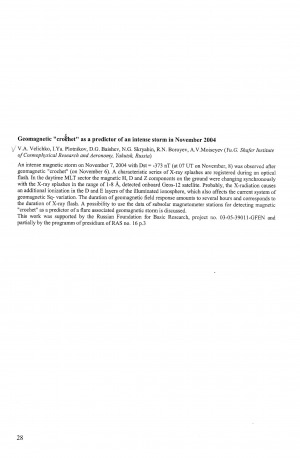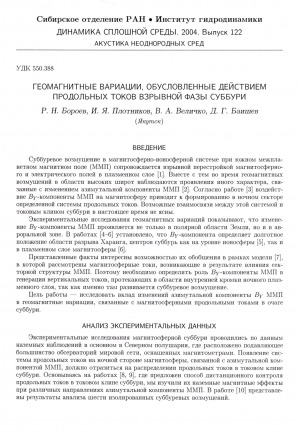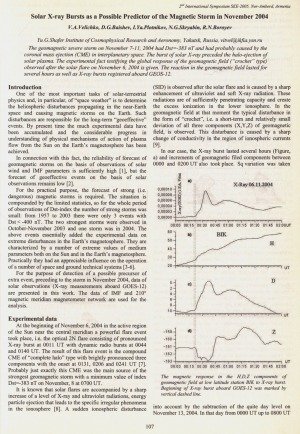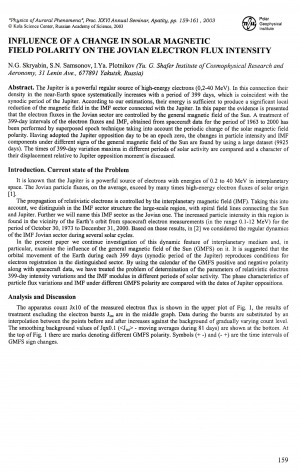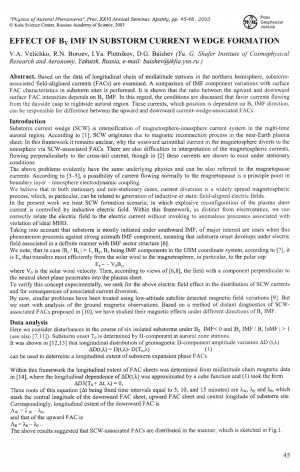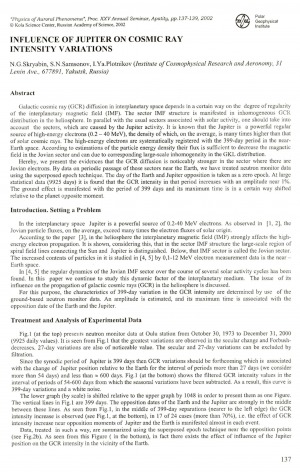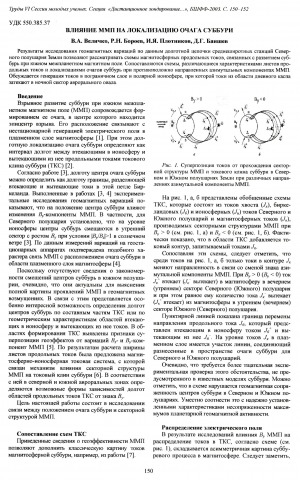Место работы автора, адрес/электронная почта: Институт космофизических исследований и аэрономии им. Ю. Г. Шафера СО РАН ; 677980, г. Якутск, пр. Ленина, 31 ; https://ikfia.ysn.ru
Ученая степень, ученое звание: канд. физ.-мат. наук
Область научных интересов: Космические исследования, геофизика
ID Автора: РИНЦ AuthorID: 29374
Деятельность: В 1965-2017 гг. - работал в Институте космофизических исследований и аэрономии им. Ю. Г. Шафера СО РАН.
Количество страниц: 2 с.
Geomagnetic "croshet" as a predictor of an intense storm in November 2004 : [тезисы докладов] / V. A. Velichko, I. Ya. Plotnikov, D. G. Baishev, N. G. Skryabin, R. N. Boroyev, A. V. Moiseyev // Physics of auroral phenomena : 29th annual seminar, 27 February – 3 March 2006 : abstracts. – 2006. – P. 28.
Количество страниц: 4 с.
Геомагнитные вариации, обусловленные действием продольных токов взрывной фазы суббури / Р. Н. Бороев, И. Я. Плотников, В. А. Величко, Д. Г. Баишев // Динамика сплошной среды. – 2004. – Вып. 122 : Доклады Всероссийской школы-семинара "Фундаментальные и прикладные проблемы физики на Севере", Якутск, 24-28 июня 2003. – С. 40-43.
Количество страниц: 2 с.
- Математика. Естественные науки > Астрономия. Астрофизика. Исследование космического пространства. Геодезия,
- Математика. Естественные науки > Геология. Геологические и геофизические науки,
- НАУКА ЯКУТИИ > МАТЕМАТИКА. ЕСТЕСТВЕННЫЕ НАУКИ > Астрономия. Астрофизика. Исследование космического пространства. Геодезия,
- НАУКА ЯКУТИИ > МАТЕМАТИКА. ЕСТЕСТВЕННЫЕ НАУКИ > Геология. Геологические и геофизические науки.
Solar X-ray Bursts as a Possible Predictor of the Magnetic Storm in November 2004 / V. A. Velichko, D. G. Baishev, I. Ya. Plotnikov, N. G. Skryabin, R. N. Boroev // Solar Extreme Events Fundamental Science and Applied Aspects Nor-Amberd, Armenia 26-30 September 2005 : proceedings of the Second International Symposium / edited by A. Chilingarian and G. Karapetyan. − Erevan : Cosmic Ray Division, Alikhanyan Physics Institute, 2006. − P. 107-108.
Количество страниц: 3 с.
Skryabin, N. G. Influence of a change in solar magnetic field polarity on the Jovian electron flux intensity / N. G. Skryabin, S. N. Samsonov, I. Ya. Plotnikov // Physics of auroral phenomena : proceedings of the 26th annual seminar, 25 - 28 February 2003. – 2003. – P. 159-161.
Количество страниц: 4 с.
Effect of Bγ IMF in substorm current wedge formation / V. A. Velichko, R. N. Boroev, I. Ya. Plotnikov, D. G. Baishev // Physics of auroral phenomena : proceedings of the 26th annual seminar, 25 - 28 February 2003. – 2003. – P. 45-48.
Количество страниц: 4 с.
Skryabin, N. G. Influence of Jupiter on cosmic ray intensity variations / N. G. Skryabin, S. N. Samsonov, I. Ya. Plotnikov // Physics of auroral phenomena : proceedings of the 25th annual seminar, Apatity, 26 February – 1 March 2002. – 2002. – P. 137-139.
Количество страниц: 3 с.
Влияние ММП на локализацию очага суббури / В. А. Величко, Р. Н. Бороев, И. Я. Плотников, Д. Г. Баишев // Труды VI сессии молодых ученых "Волновые процессы в проблеме космической погоды" [15-20 сентября 2003 г.]. - Иркутск : ИСЗФ, 2003. - С. 150-152.
Год выпуска: 1998
